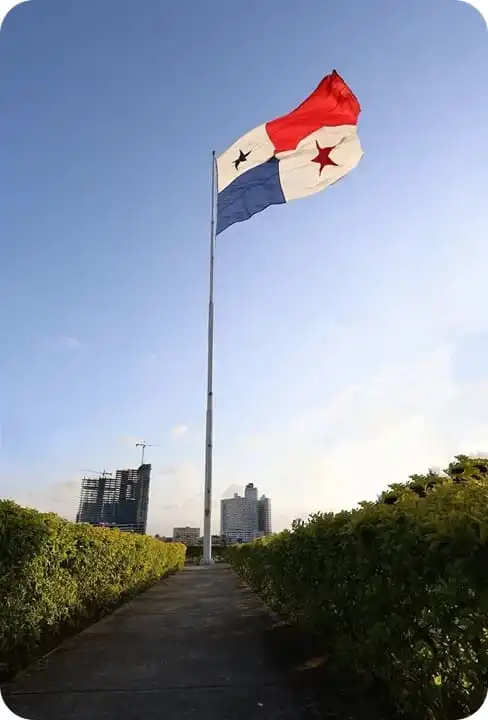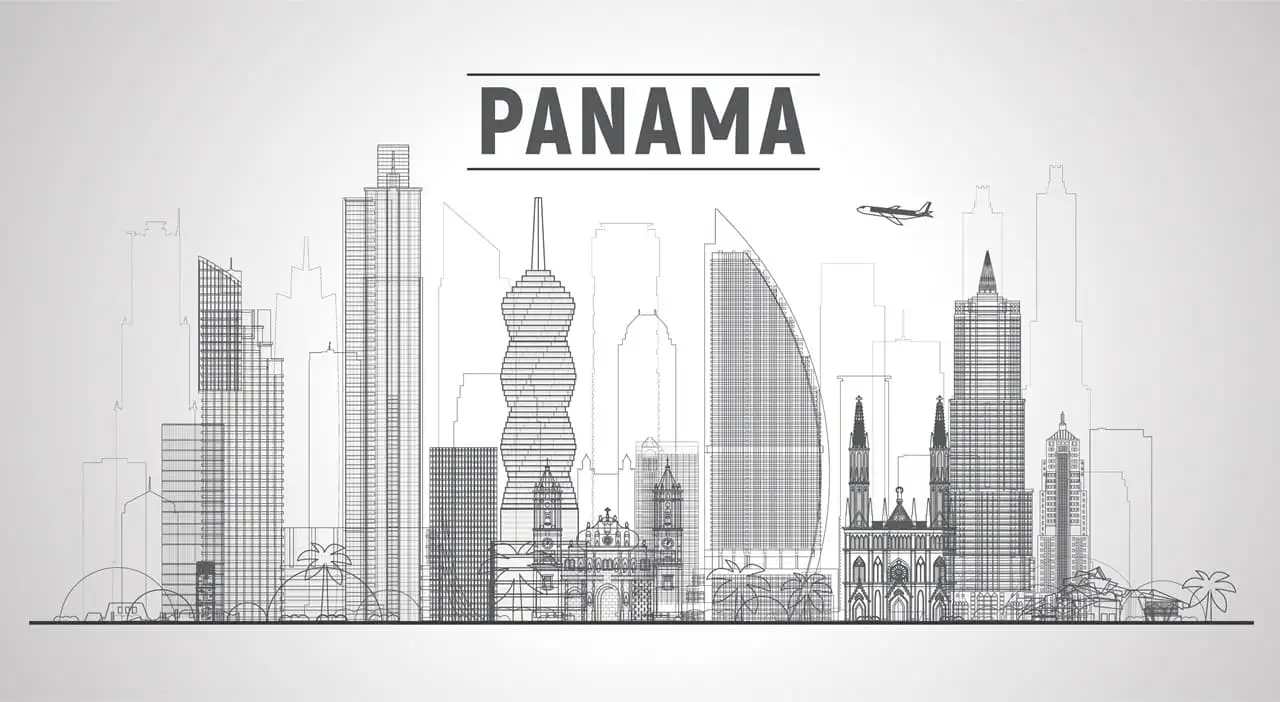Population
GDP (per capital)
Visa-Free Countries
GDP (purchasing power parity)
-
Comprehensive 2025 Guide to Immigrating to Panama
- Panama stands out in 2025 as a prime destination for relocation, thanks to its dollar-based economy, strategic location, political stability, and warm climate. Its streamlined immigration programs are especially appealing to investors, retirees, entrepreneurs, and remote professionals, offering flexible pathways to residency through real estate, business investment, or passive income—with the added benefit of long-term security and access to a growing, globally connected economy.
- Main Industries
- Banking and Financial Services
- Shipping and Maritime Trade
- Logistics and Transportation Hub
- Tourism and Ecotourism
- Agriculture and Food Exports
- Construction and Infrastructure Development

EST (UTC−5)
75,417 km2
Spanish
Balboa (PAB) & USD
Panama City

Overview of Panama’s Immigration Framework
Panama offers several structured residence-by-investment programs, each tailored to different profiles and goals:
- Friendly Nations Visa: Available to citizens of 50+ qualifying countries (e.g., USA, UK, Canada). Requires a real estate purchase or fixed-term deposit—typically US$200,000—and provides a path to temporary residency followed by permanent status and a work permit.
- Qualified Investor Visa (“Red Carpet”): Grants immediate permanent residence in exchange for an investment of US$300,000 in real estate, US$500,000 in securities, or US$750,000 in a fixed bank deposit, all held for at least five years.
- Forestry Investor Visa: For environmental investors, US$100,000 in reforestation projects qualifies for temporary residency, while US$350,000 secures immediate permanence.
- Pensionado Visa: Designed for retirees with a guaranteed income of US$1,000/month, plus US$250 per dependent, offering tax incentives and healthcare access.
- Humanitarian Security Protection Permit: Introduced in 2025, this new pathway assists irregular migrants—providing legal residency for those who meet humanitarian criteria.
The common trajectory across these programs typically begins with temporary residency, transitions to permanent status (often after 2–5 years), and culminates in citizenship eligibility after five years of continuous legal residence.
Although Panama doesn’t offer a direct “golden passport,” its investment-based visas provide a reliable route to residency and eventually citizenship—with access to a stable, dollarized economy, favorable tax regime, and global connectivity.

Immigration to Panama Without Investment (2025)
Immigration to Panama Without Investment (2025)
While Panama is well known for its investor-friendly residency options, not all immigration routes require financial investment. In 2025, the country continues to offer several accessible pathways for those seeking to relocate based on family ties, education, employment, humanitarian grounds, or remote work. These alternatives provide flexible options for individuals and families looking to establish legal residency without major capital commitments.
Family Reunification Visa
Who is it for?
Foreign nationals with close family ties to Panamanian citizens or legal residents—such as spouses, children, or dependent parents.
Requirements:
- Marriage certificate, birth certificate, or legal guardianship documents (apostilled and translated)
- Proof of economic dependence or cohabitation
- Valid passport and police clearance
- Medical certificate issued in Panama
Fees:
- Government fees: ~$250–$500 USD
- Lawyer/processing fees: Optional, ~$600–$1,000 USD
Processing Time:
- 2 to 4 months for temporary residency approval
- Permanent residency possible after 2 years of legal stay
Student Visa
Who is it for?
International students enrolled in accredited Panamanian educational institutions (e.g., universities, language schools, or vocational programs).Requirements:
- Official letter of admission from the institution
- Financial proof of ability to support living and tuition costs
- Police clearance from country of origin
- Health certificate issued by a Panamanian doctor
- Passport valid for at least one year
Fees:
- Visa application fee: ~$100–$200 USD
- Medical and documentation costs: ~$150–$300 USD
Processing Time:
- Typically, 4 to 8 weeks
- Renewable annually for the duration of the academic program
Work Visa (Labor Immigration)
Who is it for?
Foreigners offered employment in Panama, particularly under legal employment quotas or special technical skill categories.Requirements:
- Formal job offers or contract from a Panamanian employer
- Employer must comply with legal quota limits (e.g., 10% foreign workers rule)
- Proof of professional qualifications or experience
- Background check and medical exam
- Employer sponsorship is usually required
Fees:
- Government filing fee: ~$500 USD
- Work permit processing: ~$200–$400 USD
- Legal assistance (optional): ~$800–$1,200 USD
Processing Time:
- Around 2 to 3 months
- Work permits valid for 1–2 years and renewable; permanent residency possible after 5 years
Humanitarian Security Protection Permit (2025)
Who is it for?
Undocumented individuals who have been living in Panama for at least 12 months without criminal records and who meet humanitarian or social integration criteria.
Requirements:
- Proof of residence in Panama for 1+ years (rental contracts, utility bills, affidavits)
- Clean criminal background from Panama and home country
- Valid passport (or alternative ID if passport is not available)
- Health and immigration review
Fees:
- Application fee: ~$300 USD
- Legal help often recommended due to case complexity
Processing Time:
- Estimated 4 to 6 months
- Initial permit valid for 2 years, renewable or convertible to longer-term residency
Digital Nomad Visa (Remote Worker Visa)
Who is it for?
Remote professionals working for foreign companies or freelancers who earn a minimum of US$36,000 per year and want to live legally in Panama.Requirements:
- Proof of remote employment or self-employment
- Annual income of at least $36,000 (bank records, contracts, tax returns)
- Passport with 6+ months validity
- International health insurance coverage
- Police clearance from home country
Fees:
- Application fee: ~$300 USD
- Lawyer/processing service (optional): ~$500–$800 USD
Processing Time:
- Typically, 30–45 days
- Visa valid for up to 18 months (initial 9 months + 9-month extension)
Benefits & Requirements of Non-Investment Immigration to Panama
Panama’s non-investment immigration options offer a balanced blend of flexibility, rights, and incentives that make legal residency accessible without large financial commitments. These pathways provide essential benefits like work authorization, education access, and healthcare, while maintaining relatively simple residency obligations and attractive tax advantages. Understanding these benefits and requirements is key to successfully navigating Panama’s immigration landscape in 2025.
Legal Rights and Access
Non-investment residency pathways in Panama provide a wide range of benefits. Approved residents are legally permitted to work, study, and access healthcare. Most visa types also allow applicants to include dependents, such as spouses and children, making these programs suitable for individuals as well as families.
Flexible Presence Requirement
To maintain legal residency, individuals are generally required to visit Panama at least once every two years. This low presence requirement is especially attractive for retirees, remote workers, or those with international commitments who do not plan to live in Panama full-time.
Tax Advantages
Panama’s territorial tax system means residents are only taxed on income earned within the country. As a result, foreign income is typically exempt, offering significant tax efficiency for remote workers, freelancers, and pensioners. In addition, retirees benefit from a pension-friendly regime, including discounts on healthcare, prescriptions, entertainment, and essential services.
Path to Citizenship
Most non-investment residents become eligible for citizenship after five years of continuous legal residency. However, for citizens of Spain and most Latin American countries, the naturalization period may be reduced to just two years. Applicants must demonstrate basic Spanish proficiency and show integration into Panamanian society, typically through community ties or financial self-sufficiency.
Tips & 2025 Updates on Non-Investment Immigration to Panama
Tips & 2025 Updates on Non-Investment Immigration to Panama
Navigating Panama’s non-investment immigration pathways in 2025 requires awareness of recent policy changes and strategic planning. Below are key updates and practical tips to guide prospective residents:
New Humanitarian Security Protection Permit
Introduced in 2025, the Humanitarian Security Protection Permit offers a regularization pathway for undocumented individuals residing in Panama for over one year. This permit provides legal stability, access to employment, and a route to permanent residency after eight years. Applications are accepted from March 14, 2025, to March 14, 2026, necessitating legal representation and specific documentation.
Friendly Nations Visa Adjustments
While the Friendly Nations Visa remains a popular option, it's essential to note that the initial $5,000 bank deposit requirement has been eliminated for most applicants. However, applicants must demonstrate economic or professional ties to Panama, such as employment or real estate ownership. Processing times may vary, and maintaining a physical presence in Panama is required to retain residency status.
Employment-Based Residency
For those employed by Panamanian entities, work visas are available. The 10% Quota Visa allows companies to hire foreign nationals within a 10% foreign worker quota, facilitating legal employment and residency. Applicants must provide proof of employment and meet health and background check requirements.
Documentation Essentials
Regardless of the chosen immigration pathway, applicants should prepare the following documents:
- Valid passport
- Recent passport-sized photographs
- Police background check from country of origin
- Medical certificate from a Panamanian doctor
- Proof of economic solvency (e.g., bank statements, employment contracts)
- Birth or marriage certificates (as applicable)
Processing Timelines
Processing times for non-investment residency applications can vary:
- Friendly Nations Visa: Approximately 2–4 months
- Humanitarian Security Protection Permit: 4–6 months
- Work Visas: 3–6 months, depending on the employer and applicant's qualifications
Conclusion
Panama’s non-investment immigration pathways continue to offer accessible and flexible options for individuals and families seeking legal residency without substantial financial commitments. With recent updates like the humanitarian permit and adjustments to popular programs such as the Friendly Nations Visa, applicants benefit from streamlined processes and expanded opportunities. By staying informed about evolving regulations and preparing documentation carefully, prospective residents can confidently navigate Panama’s welcoming immigration landscape and enjoy the country’s many social, economic, and cultural advantages.
FAQ about Comprehensive 2025 Guide to Immigrating to Panama
Who qualifies for Panama’s Family Reunification Visa?
Close relatives of Panamanian citizens or legal residents—including spouses, children, and dependent parents—are eligible to apply for this visa.
How long does the Student Visa process usually take?
Typically, it takes about 4 to 8 weeks to obtain a Student Visa once all required documents and enrollment proof are submitted.
What are the residency requirements to maintain non-investment visas?
Most non-investment visas require the holder to visit Panama at least once every two years to keep the residency status valid.
What is the new Humanitarian Security Protection Permit?
Introduced in 2025, this permit allows undocumented residents who have lived in Panama for over a year to regularize their status and eventually apply for permanent residency.
Looking for expert visa support?
PROGRAM MATCH
Compare the different programs in a nutshell and discover their features
PROGRAM COST
Check the cost estimates for each offered program
PROGRAM MAP
Explore the power of global mobility for every passport in the world
